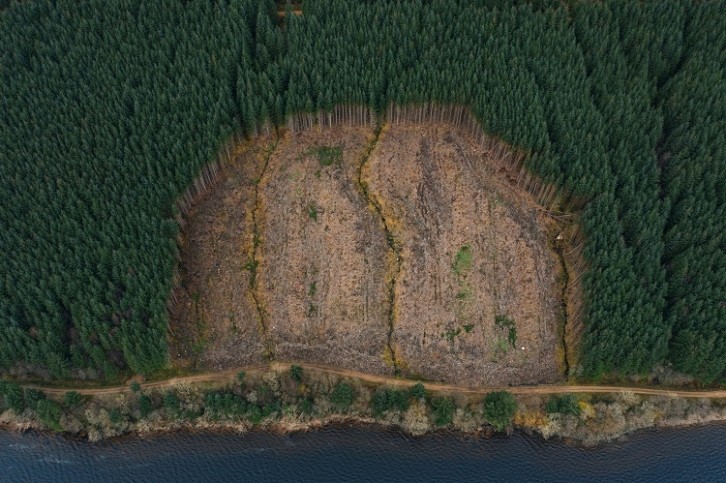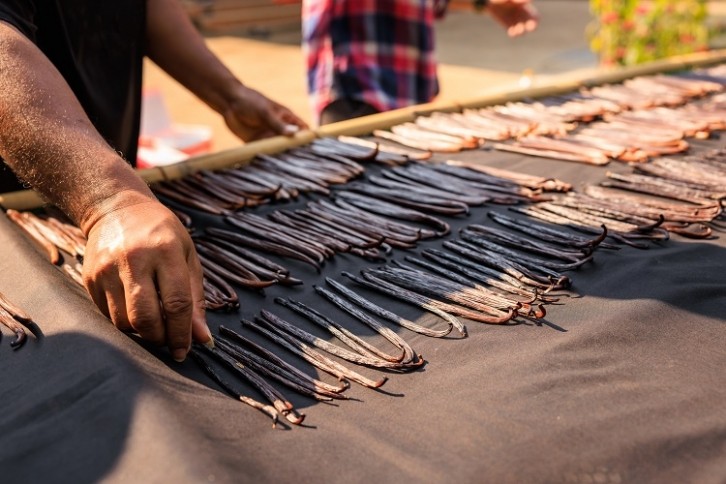From ice creams and custards to cakes and confectionery, vanilla is a firm favourite in the world of flavours. But is our dependence upon this fragrant spice sustainable?
What is vanilla?
Vanilla is a spice derived from orchids of the genus Vanilla. It’s grown within 10-20 degrees of the equator and is a major crop of Madagascar, Mexico and Tahiti.
As with wine, chocolate and coffee, vanilla has its own distinctive flavour profile and characteristics, depending on the country it’s grown in. This is a result of the different climates, soils, curing methods and vanilla species. For example, vanilla from Madagascar has a more creamy, sweet flavour, while Mexican vanilla is known for its hint of spice.
Environmental impact of vanilla
The growing of vanilla has attracted increasing criticism in recent years as it’s directly connected to the deforestation of the rainforests in the growing regions. The Sava region of Madagascar, in particular, has undergone intense deforestation in recent decades, using the slash-and-burn method.
What is the slash-and-burn method of deforestation?
This involves the cutting and burning of plants in forest or woodland areas to create a field called a swidden. The downed vegetation, or ‘slash’, is then left to dry before being burned to create a nutrient-rich layer of ash, making the soil beneath it fertile, as well as temporarily eliminating weed and pest species. However, after three to five years, the soil’s productivity decreases due to depletion of nutrients, along with weed and pest invasion, causing the farmers to abandon the field and move to a new area.
The time it takes for a swidden to recover depends on the location and can range from five years to more than twenty years, after which the plot can be slashed and burned again, repeating cycle.
“The Sava region is really a hotspot of biodiversity,” said Mimie Ravaroson of flavours and fragrances supplier Symrise at London Flavour Day, hosted by the UK Flavour Association. “This beautiful biodiversity is under threat from slash-and-burn [deforestation].”
While some ingredients, such as cocoa and coffee, have come under close scrutiny for their connection to deforestation, vanilla has received less attention.
“The EU Deforestation Regulation (EUDR) does not cover vanilla in its list of products and commodities, although in the future it could be expanded,” Rina Razanakolona, director of the Union for Ethical BioTrade (UEBT) Madagascar, told FoodNavigator.
“It is concerning to sacrifice biodiversity within precious ecosystems like those in Madagascar for the production of vanilla,” Dr Laura Kavanaugh, chief science officer for Advancing Eco Agriculture (AEA), told FoodNavigator. “Large scale deforestation not only reduces unique biodiversity but also impacts weather patterns. Given that there are artificial substitutes for vanilla, there seem to be better options for producing this flavouring.”

One example of this synthetic vanilla flavour is synthetic vanillin, a lab-produced version of the same chemical compound that occurs naturally in real vanilla. However, many consumers are increasingly turning away from synthetic flavours and ingredients and would therefore welcome a sustainable alternative to the current farming practices implemented to grow vanilla.
“Regenerative farming practices offer the greatest hope for sustainably producing any crop, including vanilla,” says Dr Kavanaugh. “By employing regenerative practices like minimising soil disturbance, maximising plant diversity through practices like cover cropping, and keeping living roots in the soil throughout the year, farmers can enhance their soil fertility. This will ensure that their land can hold water, modulate extreme temperatures, and maintain resilience to weather extremes.”
In addition to the loss of biodiversity, the loss of the trees themselves is having a direct impact on climate change. Trees and plants absorb carbon dioxide from the atmosphere as they grow. This is converted into carbon and stored in the plant’s branches, leaves, trunks, roots and in the soil. The cutting down of these trees removes this process and the burning of the plants in the slash-and-burn method then releases the carbon dioxide back into the atmosphere. However this does not mean that abandoning the production of vanilla altogether is the only solution.
“If consumer demand for natural vanilla decreases, thousands of smallholders will lose their livelihoods, often without viable alternatives,” Christiane Hornikel, lead of Herbs & Spices at the Rainforest Alliance, told FoodNavigator. “Instead, consumers can support more sustainable vanilla production avoiding deforestation by looking for products that carry the Rainforest Alliance Certified seal.
“Independent, third-party auditors, critical to the integrity of any certification programme, evaluate farms against requirements before awarding or renewing certification. The audit primarily checks to see if the required systems, controls, and incentives are in place to help ensure that sustainability requirements are followed all year round.”

Fair trade concerns over vanilla
In addition to concerns relating to the environmental impact of vanilla production, there are also concerns relating to the treatment of the farmers growing the vanilla plants.
“For vanilla farmers and Madagascan people in general, vanilla is not a food, it is not a spice, it is for money, it is for life,” says Symrise’s Ravaroson.
Despite this reliance upon vanilla for financial stability, there is growing concern that farmers are not being fairly compensated for the work they do and the product they produce.
“The Fairtrade Foundation is concerned about the treatment and challenges vanilla farmers face,” Marta Sort Creus, senior programme manager on vanilla at The Fairtrade Foundation, told FoodNavigator. “Despite, vanilla traditionally being one of the world’s most expensive spices, this does not translate into a decent income for farmers putting many families at risk. While the number of farmers and workers that grow herbs and spices is vast and diverse, the number of companies that trade and market them is not.
“Many producers work in remote areas with poor transport and telecommunication links. This increases their production costs, hampers their market access, and makes them reliant on a limited number of traders.”
The farmers are also being impacted by the increase in extreme weather events resulting from climate change.
“Changing weather patterns, like the recent cyclone in Madagascar, can further fuel price fluctuations, making it even harder for smallholder farmers to earn a decent living from their crops,” added Sort Creus.
Though this is part of a negative cycle, with deforestation implemented to grow vanilla leading to the extreme weather events which impact vanilla growth, vanilla farmers need support to adopt more sustainable growing methods. They can’t do it alone. The Fairtrade Foundation is working to mitigate some of the power imbalances found in trade systems through fairer wages and the support of farmers. Like the Rainforest Alliance, the Fairtrade Foundation is also keen to highlight that no longer consuming vanilla is not the answer.
“Instead of no longer consuming vanilla, we need to ensure a secured living income for vanilla farmers in a more stable market that would enable long term growth of this iconic natural flavour, serving farmers as well as the environment,” explains a spokesperson for the Fairtrade Foundation. “Although vanilla farmers face various challenges, the cultivation of this crop also provides them with a source of income. Therefore, it is important to ensure that the farmers and workers are paid a fair income to support their families and communities.”
Innovation in vanilla production
As well as making vanilla production more sustainable in the existing growing regions, some companies are innovating to produce vanilla more sustainably elsewhere.
Founded in 2020, Israeli start-up, Vanilla Vida, is implementing smart farming techniques to overcome the “biggest pain point” for flavour houses in the natural vanilla market, an unstable supply chain. It’s cultivating vanilla in climate-controlled greenhouses in Israel, mitigating the most common risks associated with vanilla growing, while also producing higher yields.
“You can do three seasons every two years, because your growing cycle is shorter,” co-founder and CEO, Oren Zilberman, told FoodNavigator.
Other organisations, such as the Sustainable Vanilla Initiative (SVI), are also working to improve the sustainability to naturally-grown vanilla by creating a,” long-term stable supply of high-quality, natural vanilla, that is produced in a socially, environmentally and economically sustainable way.”
